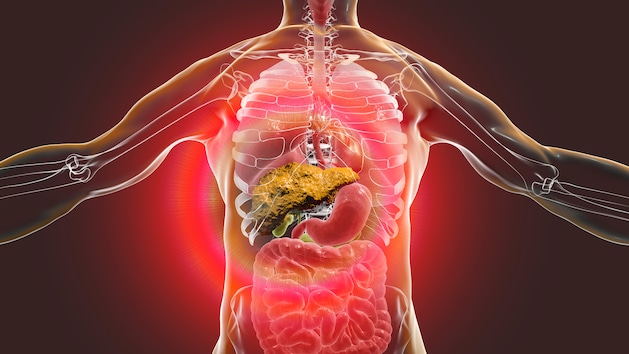How healthy is my liver? Does it contain traces of too much alcohol or is it even fatty? A simple blood test shows how the liver is doing and whether there may be liver inflammation. Two values are particularly important.
When the doctor says after the blood test: Your liver values are elevated, everyone is a little shocked at first. But it depends on what values are involved and how strong the increase is. There are different liver values, specifically these are certain enzymes whose concentration in the blood increases in liver diseases.
“Many general practitioners then talk primarily about GammaGT and quickly conclude that it is alcohol,” reports Markus Cornberg, Medical Director of the German Liver Foundation and Senior Physician at the MHH Clinic for Gastroenterology, Hepatology and Endocrinology. GGT, as it is abbreviated, reacts particularly sensitively to liver stress. Often it is not alcohol that is to blame for the increase, “but rather a biliary tract disease or a viral infection, such as a bad cold,” the expert clarifies.
These two liver values are particularly important:
The values of GOT and GPT should be under 35 for women and under 50 for men.
“If these values are significantly increased, there could be something very serious and acute behind it, such as acute hepatitis,” warns the professor. Then you should definitely consult an expert, i.e. a gastroenterologist or hepatologist.
But even moderately elevated liver values should not be dismissed as “just drink less alcohol for a while”. You should always take them seriously, warns Markus Cornberg. In any case, a follow-up check is necessary to determine whether the liver values have fallen again.
If not, hepatitis can always be the cause, and there are also liver diseases, says the expert, in which the values fluctuate. This means that sometimes the liver values are almost normal, then they rise again, then they fall again.
However, the most common cause of elevated liver values is fatty liver disease, with doctors choosing between
differentiate. At least a quarter of the population in Germany is affected by fatty liver disease.
The secondary diseases that arise on the basis of a fatty liver are expressed by increased liver values, these are:
Fatty liver hepatitis, again depending on the trigger, is divided into “non-alcoholic fatty liver inflammation” (NASH) and “alcoholic fatty liver inflammation” (ASH) caused by alcohol consumption. Experts expect two million people to be affected here.
In addition to fatty liver and fatty liver hepatitis, viral hepatitis such as hepatitis B and C are the most important reasons for an increase in liver values. Up to 800,000 patients in Germany live with chronic viral hepatitis.
Ultimately, liver values are also increased in liver cirrhosis and liver cancer, but also in many other liver diseases such as
By the way, the number of unreported cases of most liver diseases is high. Because the liver is not sensitive to pain, it suffers in silence, so to speak. There are often no symptoms until the late stage – even in acute hepatitis, classic jaundice only occurs in around 20 percent. Many liver diseases are chronic and are often only discovered late, for example through a blood test or an ultrasound scan of the upper abdomen.
Fatty liver diseases with their consequences, fatty liver hepatitis, liver fibrosis, liver cirrhosis and liver cancer, in particular, are increasing. So it definitely makes sense to have the blood test done. However, it is not (yet) part of the regular check-up 35, even though it is so important. The costs are usually not covered by the health insurance companies, but usually amount to a few euros.
The last two groups could have been infected with viral hepatitis.
The treatment of liver diseases has improved greatly. If detected early, most patients can be treated well or even cured. One example is viral hepatitis C, which can now be cured in over 95 percent with two to three months of tablet therapy with few side effects.
Having your liver values checked and, if they are slightly elevated, having the results checked after a few weeks is definitely important and can be life-saving. Nevertheless, many people are afraid to have the small blood test carried out.
On the one hand, this is certainly due to the fact that elevated liver values are still primarily incorrectly associated with too much alcohol (“drunkard’s liver”). The fact is, however, that lack of exercise and poor nutrition are often the cause. And these two risk factors now affect at least one in two people.
Ultimately, however, the liver still has a reputation as a “dirty organ,” even though it is a vital organ, similar to the heart. Liver diseases are still perceived differently than, for example, heart disease. “A heart attack is more socially accepted than liver cirrhosis,” compares Markus Cornberg.
The heart attack is probably also caused by a lack of exercise, poor diet, alcohol and smoking – just like liver cirrhosis – but is considered a manager’s disease. Fatty liver, liver cirrhosis and other liver diseases, on the other hand, are rather taboo and that is why many people don’t even want to know whether their liver is OK. They fail to detect liver diseases early and thus massively increase the chances of recovery.















